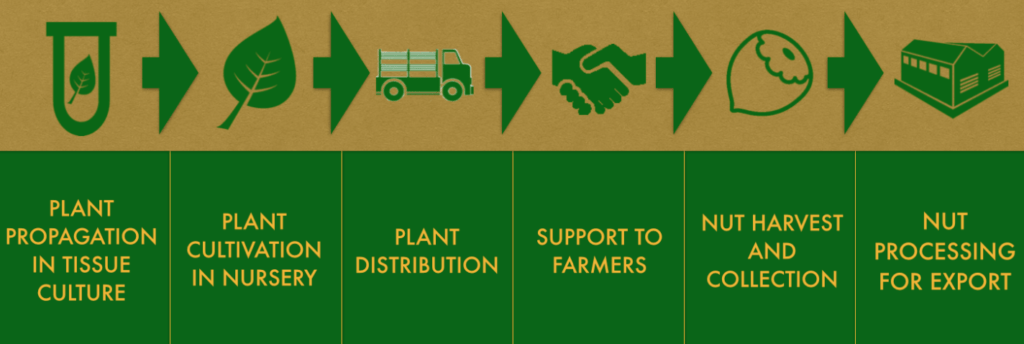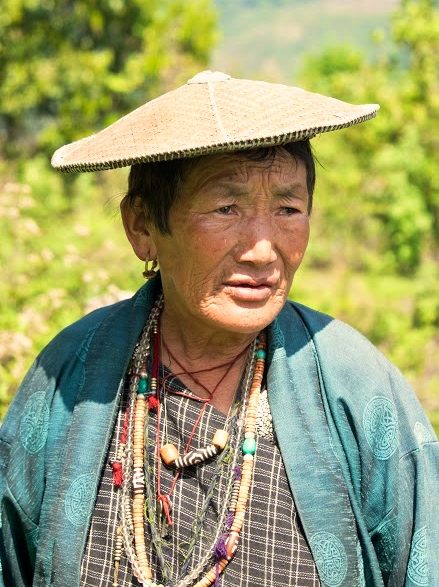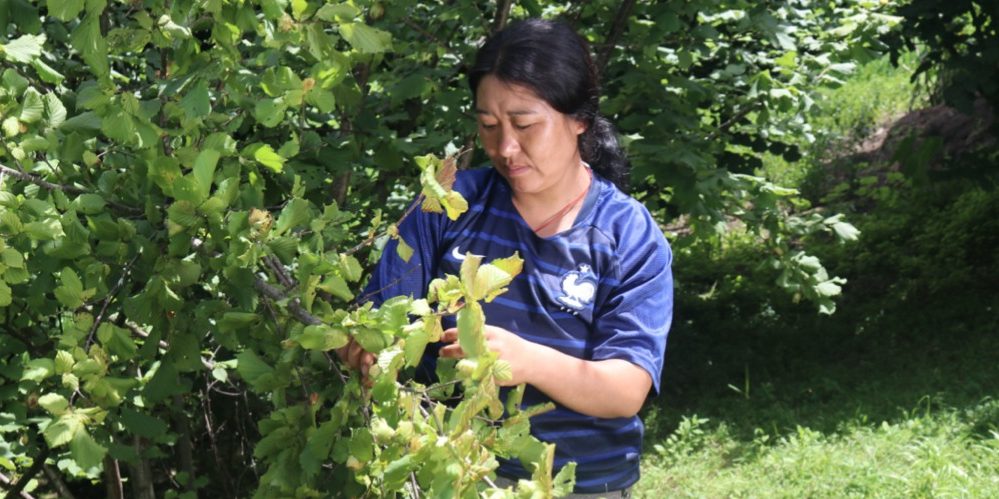Is hazelnut the new treasure of Bhutan? Tucked between China and India, Bhutan is a small landlocked country of 750,000 inhabitants, better known for its dramatic landscapes, deep-rooted spiritual culture and Gross National Happiness (GNH) Index than for its production of hazelnuts. However, this might change as the country’s first 100% Foreign Direct Investment (FDI) company is reinventing the hazelnut global supply chain. By aligning profit with purpose, Mountain Hazelnuts (MH) aims to capture 3% of the US$7 billion global hazelnut market and expects to significantly increase the income of 15% of Bhutan’s population.
BACKGROUND
Company Overview
Headquartered in Lingmethang, Mongar (Eastern Bhutan), Mountain Hazelnuts is an ambitious impact venture which aspires to develop world-class production of hazelnuts in the newly democratic Kingdom which recently opened its doors to the world. For this purpose, it is planting 10 million hazelnut trees on fallow and degraded land.
MH was founded in 2008 by Daniel Spitzer and Teresa Law with a clear vision: to provide a long-term source of income to vulnerable communities of smallholder farmers while delivering fair and sustainable return to investors. Through an innovative business model, this agribusiness has created an inclusive and environmentally sustainable value chain, reducing rural-to-urban migration while preventing land erosion and ultimately fighting climate change.
The Company has become the largest private sector employer in Bhutan, with 800 direct employees, and also supports approximately 1,200 entrepreneurs who supply goods and services to the Company. “Currently 10% of Bhutan’s population is involved with us, either as growers or participants in the hazelnut value chain,” explains Spitzer. By developing world-class hazelnut production, the venture is conceived of as a win-win for business and society. While the financial return on investment will be realised on a longer time scale, the social and environmental impact of Mountain Hazelnuts’ activities is already well-established.
Social Issues
Over the past 30 years, Bhutan has had a very high rate of rural-to-urban migration. The latest census revealed that 22% of the national population has moved from rural areas to urban centres. This mass migration is linked to more modern living conditions in cities and a sometimes unfounded hope of more attractive economic prospects. Poverty in Bhutan is indeed largely a rural phenomenon, and agriculture is primarily subsistence farming. As a result, 11.9% of the rural population lived in poverty compared to 0.8% in urban areas in 2017.
Rural conditions have improved considerably through government benefit programmes over the years, but farmers have few opportunities to earn cash income. At this time, 62% of the population still lives in rural areas. Most of the migrants are young people aged between 25 and 29, looking for employment and education opportunities in the city. This internal migration leaves many villages empty and weakens the nation’s tight-knit and cohesive social fabric.
Environmental Issues
Bhutan is one of the world’s most bio-diverse countries, being home to thousands of plant and animal species. However, “slash and burn” cultivation and population pressure have led to deforestation, eroding local ecosystems.
Degraded land erodes 5 to 50 times faster than forested areas. Valuable topsoil, washed away by monsoon rains, ends up as silt in the rivers. Hillsides become less productive and unstable, while water quality degrades. The whole process contributes to global climate change as it releases carbon dioxide (CO2) into the atmosphere, which was previously sequestered in both the trees and the soil.
Business Opportunity – the Hazelnut Market
From confectionery to savoury dishes, the use of hazelnuts is extensive. Representing the world’s second most valuable tree-nut market after almonds, global hazelnut demand is over US$8 billion annually. Demand for hazelnuts is expected to grow by 5.9% per year through to 2026. Europeans increasingly value its antioxidant qualities, while China’s appetite for hazelnuts-based snack foods keeps growing.
Hazelnuts require specific conditions to be productive, including sunlight exposure in the summer, cool winters and a mid-elevation climate. Worldwide, hazelnut supply is concentrated in the hands of a few players. Turkey produces more than 70% of global supply, but relies on labour-intensive and low-yielding methods. Other producers include Italy, Spain and the USA, although they lag far behind Turkey’s production.
Hazelnuts are very well suited to Bhutan’s agro-climatic conditions and are indigenous to the region. However, Bhutan had never cultivated hazelnuts commercially before Mountain Hazelnuts arrived.
Business Opportunity – From PTP to MH
The Company is modelled after Spitzer’s previous venture in China: Plantation Timber Products (PTP). Much like Mountain Hazelnuts, PTP engaged rural farmers to grow trees on degraded Himalayan slopes from which PTP produced sustainable wood products. The mission-driven company, sold in 2004, was a resounding success, generating three- fold returns to investors while benefiting 700,000 local farmers who planted more than 200 million trees.
Spitzer and Law sought to replicate the PTP model and first considered ventures in Western China, but the 2008 Sichuan earthquake turned their plans to Bhutan. The timing was right. The Kingdom had just had its first democratic election and was contemplating opening up to international investment. Drawing on their experience and best practices from PTP, the couple reckoned they could compete with the relatively inefficient world players in hazelnuts’ profitable niche market.
CSV BUSINESS MODEL
Business model

Mountain Hazelnuts’ business model relies on establishing a set of mutual obligations with rural farmers. Tree saplings, grown in the company’s state-of-the art nurseries, are provided at no cost to growers, who are contractually bound to plant on fallow or degraded land with no existing commercial use. MH also provides training and support on orchard management best practices for nurturing hazelnut crops. Once the trees bear fruit, growers bring the hazelnut harvest to collection points and sell it to the Company at a guaranteed minimum price.
This model is a good fit for Bhutan’s social-economic conditions. Compared to other potential cash crops, hazelnuts do not require heavy upfront investments from farmers. The model is inclusive: those with no suitable land can lease it from the government. Women or the elderly, who tend to enjoy less financial security, can tend the low maintenance crop. Incremental earnings are also significant: an average orchard is expected to double a typical rural household income.
By improving the lives of participating growers, Mountain Hazelnuts helps reduce rural- to-urban migration and sustain local communities. It also contributes to a more inclusive society, offering economic opportunities to the most financially vulnerable. Moreover, planted trees act as retaining walls, stabilizing the soil, reducing erosion and cleaning up the water. The trees sequester CO2 in the fight against climate change.
This positive impact is reinforced by a long-term collaboration with the Royal Government of Bhutan (RGoB). Mountain Hazelnuts operates as a public-private- community partnership which aligns the interests of the Company, the RGoB and the wider community.

CSV aspect
“Times have changed,” says Spitzer. “At the time we founded Plantation Timber Products, you couldn’t talk about Shared Value because you would be considered a softie- not being able to make the tough decisions sometimes required to drive performance”. Traditional capitalism used to be the alpha and omega of business, but Creating Shared Value (CSV) is gaining traction as a strategy to create competitive advantage and future- proof a business by addressing societal issues.
Mountain Hazelnuts is a CSV-born business. From its inception, the Company sought to integrate positive social impact at the core of the business model, beyond the limited Corporate Social Responsibility (CSR) and “do no harm” approaches.
The business is built on a three-fold objective: fair return for investors, attractive benefits for partner communities, and positive impact on the environment. The Company’s commitment is “to justify its existence through outstanding performance in each of these spheres”. Profitability is key to the overall success as it warrants the sustainability and scalability of the business.
Mountain Hazelnuts creates Shared Value on two levels: redefining the productivity in the value chain and enabling local cluster development. First, the firm has unlocked an untapped resource, which can be cultivated in a low-cost and high-quality manner. It has developed an innovative supply chain, which provides full traceability and benefits all stakeholders. Second, the public-private-community partnership closely links the Company with the Bhutanese government and its people, creating synergies and boosting local economic development. New businesses and services are attracted to the region (e.g. new bank branches and schools), infrastructures are revamped and world- class skills, formerly inaccessible for locals, are transferred – creating a thriving cluster.
CHALLENGES
Partnerships
Partnerships are key to CSV but they are not easy to implement, especially at a national scale. “We had about 200 meetings over 6 months before the Memorandum of Understanding was approved, including diverse groups ranging from Government Ministers, members of Parliament, civil service officials, farmer representatives, and senior spiritual leaders.” remembers Law. While the idea behind Mountain Hazelnuts resonated with the concept of GNH, months of negotiation and trust-building were needed in a nation which was learning the ropes of both democracy and international investments.
Spitzer and Law initiated the idea of MH as a public-private-community partnership, undertook detailed joint feasibility studies with the Ministry of Agriculture and Forests, laying the foundation for an open and collaborative partnership with the RGoB. The investors demonstrated their deep CSV commitment by pledging 20% of its net profits to the Hazelnut Trust Fund to benefit Bhutan’s communities, culture and environment.
Beyond the national government, Mountain Hazelnuts engages with many levels of stakeholders – from growers to international investors – whose goals need to be aligned. The Company has a targeted approach for each group, providing regular updates on the vision and progress of MH. Besides these “formal” communication channels, it has established a comprehensive system of “informal” relationships with key stakeholders at a local level.
Mountain Hazelnuts has identified two main stakeholder groups: the local government branches – the company works in 18 of the 20 Dzongkhags (districts) of Bhutan – as well as the growers and communities (including monasteries, nunneries, etc.) within which it works. The Company has trained a strong network of managers leading local teams in each Dzongkhag. MH deploys 150 field extension workers who visit growers every 60 days to provide orchard management support and collect data, and 300 community lead growers (farmers who take a lead in their communities). Furthermore, MH has developed an innovative mobile phone application, coined the “Field Companion”. This provides a direct interface with growers and allows smooth communication between growers and Mountain Hazelnuts to tackle crop issues as soon as they arise.
Financing
Financing the US$30 million impact venture was another key challenge. To prove the viability of the project, the couple funded the Company for its first five years of development. Mountain Hazelnuts then relied on blended finance, which mixes public, philanthropic and private capital to achieve maximum social impact. The public financing with below-market interest rates cushions risk and boosts investment returns, allowing the leveraging of private capital. Blended financing thus brings positive results for both investors and communities and is often used in frontier markets.
However, even with its strong economic proposition, Mountain Hazelnuts encountered a few hurdles when looking for funding from institutional investors. Many potential investors found the structure too risky as the Company neither owns the trees nor the land the hazelnuts are grown on. Its success depends on the success of its grower partners, and it must work closely with the government to resolve logistical issues in a country with unique infrastructure challenges.
The International Finance Corporation (IFC), which had backed PTP with a series of debt and equity financings, was keen to invest MH after its due diligence in Bhutan, but the two sides disagreed on the deal structure. It was only after the Global Agriculture and Food Security Program (GAFSP) joined the project to offer a blended financing package – which played a bridging role between traditional equity and debt, thereby reducing the overall financial risk – that the IFC and Asian Development Bank (ADB) were able to offer investment terms that MH considered acceptable.
ADB recognized Mountain Hazelnuts as its Best Corporate Finance Transaction globally in 2015 – a remarkable achievement for the relatively small business compared to the billions of dollars of other ADB deals. MH’s next stage of development is in sight: It just secured a US$9 million landmark long-term financing agreement with the United Nation’s Land Degradation Neutrality (LDN) Fund managed by Mirova/Natixis.
Impact Measurement
Having meaningful data to measure impact is essential to the success of the business. Mountain Hazelnuts has built a holistic social and environmental impact management framework which includes indicators such as number of planted trees, area of mature orchards, change in farmer income, percentage of youth remaining in community, etc. Based on these indicators, the Company undertakes quarterly reviews against its objectives, and uses emergent data to adjust operations and ensure impact targets are met.
Impact measurement is complex. MH had to tweak its model a few times before getting it right. For instance, the Company actively assesses its impact on gender equality but did not initially separate data for female employees and female growers. This blurred the lines between improved career opportunities and better livelihoods for women. Mountain Hazelnuts joined Business Call to Action’s (BCtA’s) Impact Champions Programme to design a stronger impact management framework, and now has a deeper understanding of the differentiated impact of its operations on different stakeholder groups. This has also led to improved decision-making, driving value for the business and its stakeholders.
“Building a commercial industry from scratch in the Himalayas isn’t for the faint-hearted! But after nearly 30 years in the business world, Daniel and I felt that we’d ‘been there, done that’ and wanted to commit ourselves to a project where we could do something meaningful together.Mountain Hazelnuts combines many of our interests – strengthening communities, addressing women’s issues, broadening rural services, dealing with climate change – each day is an adventure for us,” according to Law.
RESULTS
Numbers
So far, Mountain Hazelnuts has planted 7 million trees and is well on track to accomplish its objective of planting 10 million trees. It currently involves 12,000 growers and harvested 24 metric tons of hazelnuts in 2019. The venture expects the peak harvest to be 40,000 tons of hazelnuts, which would make Bhutan one of the five largest hazelnut exporters in the world.
Mountain Hazelnuts could impact Bhutan’s economy significantly with exports expected to increase by 10%, with a real GDP contribution of more than 5%. It has already improved the livelihoods of over 10% of the Bhutanese population and is leading the way towards a more inclusive society.
Nearly half of Mountain Hazelnuts’ employees are women and the Company has given financial literacy training to more than 4,000 women heads-of-household. Environmentally, the Company has already planted trees on more than 7,000 hectares of formerly fallow and degraded land. Over the lifetime of the project, the hazelnut trees planted are expected to sequester a total of 8 million metric tons of CO2. However, these outcomes are only the tip of the iceberg as the Company’s full impact penetrates to the heart of community development.

What’s Next
Looking to the future, Mountain Hazelnuts plans to expand its reach with programs such as the Youth Engagement and Livelihoods Program (YELP). The program, still in its pilot phase, aims to train unemployed youth to run an agricultural business during a 12-month internship. This could include businesses along the Company’s value chain supporting Mountain Hazelnuts’ operations while benefiting Bhutanese agriculture. At scale, MH expects to train up to 100 unemployed youth annually.
Operationally, MH is planning to expand its existing processing factory, develop an e- payment system for thousands of growers across the country, and finalize export logistics to ensure its large, high quality hazelnuts get into consumers’ hands. The next few years will also be critical to establish Mountain Hazelnuts as a key “Brand Bhutan” product.
The business is also looking to replicate its “tried and tested” model. Domestically, Mountain Hazelnuts is exploring with the United National Development Program (UNDP) to scale its technological and operational innovations, such as its Field Companion application, to relevant RGoB departments. Internationally, it has provided training on its technological innovations for agriculture-focused social ventures in Africa, and is currently testing its business model in other Himalayan countries such as Nepal and India (Sikkim).
Inspire & CSV
Mountain Hazelnuts seeks to be an inspiration for other impact ventures. Beyond its remarkable technological innovations, the Company hopes that its model of long-term public-private-community partnership will be replicated elsewhere.
Mountain Hazelnuts is a great example of Creating Shared Value – solving socio- environmental issues while delivering a fair return to investors. By aligning profit and purpose, the Company aims to improve the livelihood of thousands in underserved communities in the remote Himalayan kingdom.
| Social Benefits | Business Benefits |
|---|---|
Improved livelihoods – 10% of Bhutan’s population impacted (objective: 15%) | Revenue – Expected $50 million by 2025 with strong margins for growers and MH |
Increase of Bhutan exports by 14.9%, boosting real GDP by 5.7% | Market share – Become a top-5 hazelnut producer in the world |
Stronger communities – Rural-urban migration reduced, preserved communities | Blended finance – Better access to capital ensuring faster development |
Fight against climate change – 7M trees planted (objective: 10M), capturing a total of 8M tons of CO2 over the tree’s lifespan | Strong partnerships – Higher business resilience through close relationships with governments and communities |
Local ecosystem – 7,000 hectares of slopes restored (long-term goal: 10,000+ ha) | Full traceability & premium quality – Especially valuable for European markets |
| Inclusive society – 6,256 of women empowered | Unique value chain – Differentiator in the industry |

